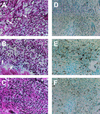Intradermal infection model for pathogenesis and vaccine studies of murine visceral leishmaniasis
- PMID: 12496190
- PMCID: PMC143149
- DOI: 10.1128/IAI.71.1.401-410.2003
Intradermal infection model for pathogenesis and vaccine studies of murine visceral leishmaniasis
Abstract
The levels of protection found in vaccine studies of murine visceral leishmaniasis are significantly lower than for cutaneous leishmaniasis; whether this is due to the high-challenge murine model employed and/or is a consequence of differences required in tissue-specific local immune responses is not understood. Consequently, an intradermal murine model of visceral leishmaniasis has been explored. Intradermal inoculation established a chronic infection in susceptible mice which was associated with a pattern of parasite clearance with time postinfection in the liver and skin; in contrast, parasite persistence and expansion was observed in lymphoid tissue (spleen and draining lymph node). The course of disease found appears to be similar to those reported for subclinical canine and human visceral leishmaniasis. Clearance of parasites from the skin was correlated with an inflammatory response and the infiltration and activation of CD4(+) and CD8(+) T cells. In contrast, in lymphoid tissue (lymph node or spleen), the production of Th1/Th2 cytokines (interleukin-4 [IL-4], IL-10, and gamma interferon) appeared to correlate with parasite burden and pathogenesis. In vaccination experiments employing the Leishmania infantum D-13 (p80) antigen, significantly higher levels of protection were found with the intradermal murine model (29 to 7,500-fold more than naive controls) than were found with a low-dose intravenous infection model (9 to 173-fold). Thus, this model should prove useful for further investigation of disease pathogenesis as well as vaccine studies of visceral leishmaniasis.
Figures




References
-
- Alexander, J., K. C. Carter, N. Al-Fasi, A. Satoskar, and F. Brombacher. 2000. Endogenous IL-4 is necessary for effective drug therapy against visceral leishmaniasis. Eur. J. Immunol. 30:2935-2943. - PubMed
-
- Alvar, J., B. Gutierrez-Solar, R. Molina, R. Lopez-Velez, A. Garcia-Camacho, P. Martinez, F. Laguna, E. Cercenado, and A. Galmes. 1992. Prevalence of Leishmania infection among AIDS patients. Lancet 339:1427. - PubMed
-
- Banchereau, J., and R. M. Steinman. 1998. Dendritic cells and the control of immunity. Nature 392:245-252. - PubMed
-
- Belkaid, Y., K. F. Hoffmann, S. Mendez, S. Kamhawi, M. C. Udey, T. A. Wynn, and D. L. Sacks. 2001. The role of interleukin (IL)-10 in the persistence of Leishmania major in the skin after healing and the therapeutic potential of anti-IL-10 receptor antibody for sterile cure. J. Exp. Med. 194:1497-1506. - PMC - PubMed
Publication types
MeSH terms
Substances
Grants and funding
LinkOut - more resources
Full Text Sources
Other Literature Sources
Research Materials

